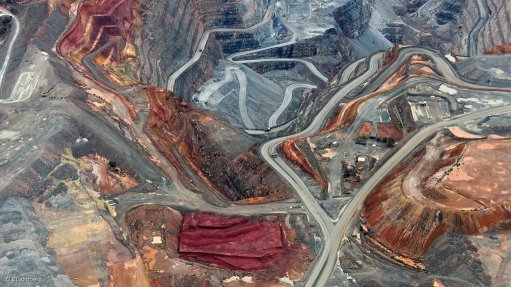
JOHANNESBURG (miningweekly.com) – Australia’s largest iron-ore miner Rio Tinto is on track to ship 330-million tonnes from its mines in the Pilbara this year, with 158.9-million tonnes having been sold in the first six months of the year.
The half-year performance was 8% better than a year earlier, Rio Tinto reported in its second-quarter production report on Tuesday.
The group, which is the world’s second-largest shipper of the steelmaking ingredient, increased second-quarter production from its Pilbara mines in Western Australia by 8% year-on-year to 80.9-million tonnes. Pilbara operations produced 160.8-million tonnes in the first half of the year, which is 10% higher than the same period of 2015.
“The performance reflects minimal weather impacts, as well as the successful implementation of operational improvements and the ramp-up of expanded and new mines across the Pilbara,” Rio Tinto stated.
Rio Tinto achieved an average pricing in the first half of 2016 of $44.5 a wet metric tonne on a free-on-board basis, which is the equivalent of $48.4 a dry metric tonne.
Australia’s Office of the Chief Economist warned recently that iron-ore prices will recover slower than previously thought, with the commodity expected to fetch an average of $44.2/t this year and $44.8/t in 2017.
Rio Tinto reported that the second phase of a project that would increase capacity by another five-million tonnes would come into production in the final quarter of the year. The Nammuldi Incremental Tonnes project delivers high-grade, low-phosphorous ore into the Pilbara blend. The initial phase of five-million tonnes started production in the fourth quarter of 2015.
The group also reported that it would announce an investment decision on the proposed 20-million-tonne-a-year Silvergrass mine before the end of 2016.
The Iron Ore Company of Canada (IOC) produced 8.5-million tonnes of concentrate and pellets, which was a 6% increase over the first half of 2015. Second-quarter concentrate and pellet production was 4.4-million tonnes, which Rio Tinto reported was in line with 2015’s performance and a 6% increase on the prior quarter.
The improvement in production increased IOC’s first-half sales by 17% to 8.6-million tonnes.
Meanwhile, Rio Tinto reported weak coking coal production results, with hard coking coal output declining by 14% year-on-year to 1.80-million tonnes and semi-soft coking coal production decreasing by 13% to 893 000 t. The company attributed the lower coking coal output to the timing of the longwall changeover at its Kestrel mine and mine production sequencing at Hunter Valley operations and Mount Thorley Warkworth.
Hard coking coal production decreased by 8% year-on-year to 3.78-million tonnes in the first half, while semi-soft coking coal output in the same period increased by 8% year-on-year to 2.06-million tonnes.
Second-quarter thermal coal production is 6% higher than a year earlier at 4.32-million tonnes, with first-half production broadly in line with the same period last year at 8.65-million tonnes.
The diversified mining group’s other second-quarter production results include that of copper, which increased by 5% year-on-year to 141 000 t, aluminium, which increased by 11% to 911 000 t, bauxite, which increased by 13% to 12.07-million tonnes and titanium dioxide slag, which decreased by 22% to 236 000 t.
“Rio Tinto has delivered another robust quarter of operational performance. We continue to focus on value and maximising cash flow from our assets, through both commercial and operational excellence while maintaining capital discipline,” commented new CEO J-S Jacques.